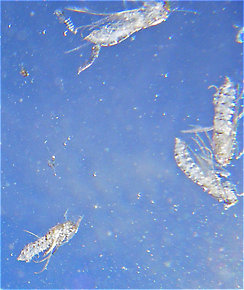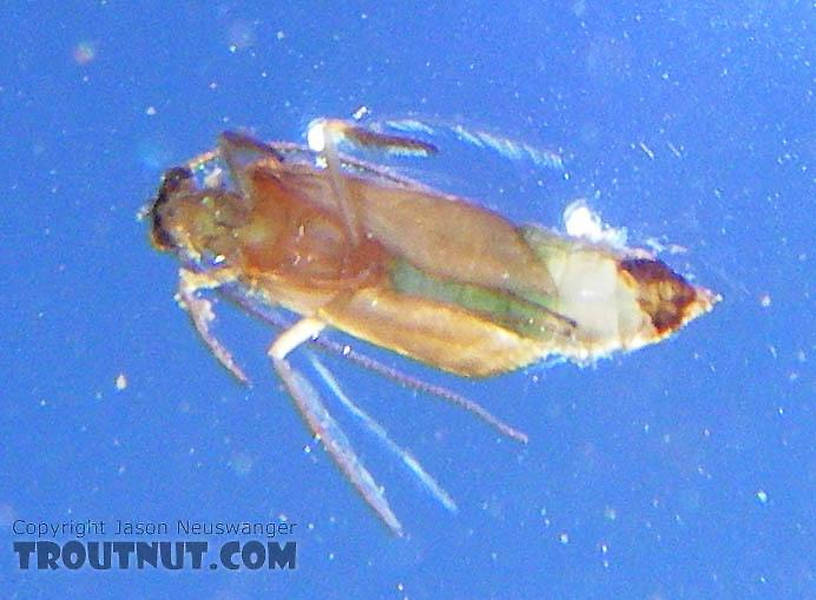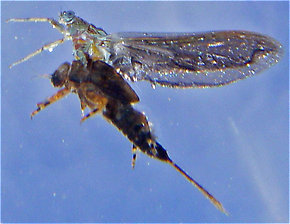Blog & Latest Updates
Fly Fishing Articles
Insects by Common Name


Insect Order Trichoptera (Caddisflies)
Taxonomic Navigation -?-
Kingdom
Animalia (Animals)
» Phylum
Arthropoda (Arthropods)
» Class
Insecta (Insects)
» Order Trichoptera (Caddisflies)
5 families aren't included.
Common Name
| Match | Common Name |
| Caddisflies |
Caddis species actually provide as much incentive to learn their specifics as the mayflies do. There is just as much variety in their emergence and egg-laying behaviors, and as many patterns and techniques are needed to match them. Anglers are hampered only by the relative lack of information about caddisfly behavior and identification.
Hatching Behavior
In many species, the pupae become very active just before emergence and drift along the bottom of the river, sometimes for hours. The "deep sparkle pupa" patterns introduced by Gary LaFontaine in Caddisflies are the most popular of many imitations inspired by this behavior. It is a deep nymph fisherman's dream. Sometimes they drift similarly just below the surface for a long time before trying to break through.
Pupae of different species use three different methods to emerge:
- Most species rise to the surface and struggle through. They usually take flight quickly once they're out of the water, but slow species first struggle and drift long distances half-submerged as they wriggle free from their pupal shucks (Shuck: The shed exoskeleton left over when an insect molts into its next stage or instar. Most often it describes the last nymphal or pupal skin exited during emergence into a winged adult.).
 Here's an underwater view of the pupal shucks of several already-emerged Brachycentrus numerosus caddisflies.
Here's an underwater view of the pupal shucks of several already-emerged Brachycentrus numerosus caddisflies. - The pupae of some species crawl out of the water on rocks, sticks, and such, so that the adults emerge high and dry.
- Some pupae rise to the surface and swim quickly across it to shore where they crawl out to emerge.
Most caddis pupae are good swimmers, and they use their legs as paddles rather than wiggling their bodies to move.
After emerging, caddisfly adults live for a long time compared to mayflies, in part because they are able to drink to avoid dehydration (mayfly adults cannot eat or drink). This flight period (Flight period: The span of time that the adults of an adult aquatic insect species are active and flying around, in between emergence and death. It may refer to the average adult lifespan of the individuals of that species, or to the total length of time for which at least some of them are active.) lasts anywhere from a few days to a few months, depending on the species, so mating adults may be seen on or over the water long after emergence is complete.
Egg-Laying Behavior
Many caddisfly females dive underwater to lay their eggs on the stream bottom. Some crawl down objects to do this but most swim right down through the water column. The latter are responsible for my fastest trout fishing action ever -- days when trout raced each other to attack my flies the moment they hit the water, cast after cast.
Others lay their eggs on the surface in various ways. They may fly low over the water, periodically dipping their abdomens to lay eggs. Others land on the surface repeatedly, fussing and fluttering in enticing commotion. Less active species may fall spent (Spent: The wing position of many aquatic insects when they fall on the water after mating. The wings of both sides lay flat on the water. The word may be used to describe insects with their wings in that position, as well as the position itself.) to the surface with all four wings spread out. Others ride the water serenely while laying their eggs, and they are the easiest to match with the dead-drift (Dead-drift: The manner in which a fly drifts on the water when not moving by itself or by the influence of a line. Trout often prefer dead-drifting prey and imitating the dead-drift in tricky currents is a major challenge of fly fishing.) techniques of mayfly fishermen.
Some egg-laying methods keep the adult females safe from trout altogether. They may drop their eggs into the water from overhanging plants, or lay their eggs on the vegetation itself. That way the eggs don't enter the river until the next rain--an excellent drought survival strategy.
Larva & Pupa Biology
Other common caddis larvae build nets instead of cases. These are not residences but hunting traps, like tiny spider webs, designed to capture plankton and smaller aquatic insects the larvae eat. One larva may build more than one net and roam freely around the rocks and logs tending to each and ingesting the catch. The net-spinning families, in order of abundance, are Hydropsychidae, Philopotamidae, and Arctopsychidae.
One large and primitive family of caddisflies, Rhyacophilidae, needs neither cases nor nets. Most of its species are predators who stalk through rocky riffles killing other insect larvae and nymphs.
All of these types are especially prone to behavioral drift (Behavioral drift: The nymphs and larvae of many aquatic insects sometimes release their grip on the bottom and drift downstream for a while with synchronized timing. This phenomenon increases their vulnerability to trout just like emergence, but it is invisible to the angler above the surface. In many species it occurs daily, most often just after dusk or just before dawn.), making them an important food source year-round for the trout in most rivers.
When caddis larvae are full-grown, they seek hiding places to pupate, either in their cases or in special cocoons. They are considered to be pupae throughout the radical reformation from grub-like larva into intricate winged adult. Some of the larva's body mass is consumed as energy for the development of the pupa, so the pupae and adults both have bodies one to three hook sizes smaller than their mature larvae. When pupation is complete, the insect which begins the emergence sequence is called a pharate adult (Pharate adult: Caddisflies are considered to be pupae during their transformation from larva into adult. This transformation is complete before they're ready to emerge. The emerging insect we imitate with the "pupa" patterns we tie is technically called a pharate adult. It is a fully-formed adult caddisfly with one extra layer of exoskeleton surrounding it and restricting its wings.). It is no longer technically a pupa in the language of entomologists, but because anglers universally recognize the term "pupa" I use that convenional misnomer throughout this site.
Sometimes individuals within the same fall-emerging species mature at different rates. In some species, mature larvae compensate for this by entering an inactive phase called diapause (Diapause: A state of complete dormancy deeper even than hibernation. While in diapause, an organism does not move around, eat, or even grow. Some caddisfly larvae enter diapause for a few weeks to several months. Some species of microscopic zooplankton can enter diapause for several hundred years.) prior to pupation. Cool fall weather triggers the end of this phase for every individual within a few short weeks, synchronizing emergences that would otherwise be spread over several months. This boosts the quality of autumn caddisfly hatches like the giant western genus Dicosmoecus.
Trichoptera Fly Fishing Tips
The presence of caddisfly adults in the air does not mean that the angler should immediately switch to an imitation. As Swisher and Richards put it in Selective Trout:
They are often seen over the water when they are doing nothing more than flying around.
More often it's the caddisflies you don't see that are important, the females diving underwater to lay their eggs or the pupae drifting below the surface preparing to emerge.
Pictures of 129 Caddisfly Specimens:
Rhyacophila fuscula (Green Sedge) Caddisfly Larva View 11 Pictures
View 11 Pictures
 View 11 Pictures
View 11 PicturesCollected April 1, 2007 from Mystery Creek #62 in New York
Added to Troutnut.com by Troutnut on April 3, 2007
Added to Troutnut.com by Troutnut on April 3, 2007
Hydropsyche aenigma (Spotted Sedge) Caddisfly Adult View 18 PicturesThese big caddisflies were tempting trout as they wriggled out of their shucks (
View 18 PicturesThese big caddisflies were tempting trout as they wriggled out of their shucks ( Shuck: The shed exoskeleton left over when an insect molts into its next stage or instar. Most often it describes the last nymphal or pupal skin exited during emergence into a winged adult.), while others skated across the water at a medium pace, probably egg-laying.
Shuck: The shed exoskeleton left over when an insect molts into its next stage or instar. Most often it describes the last nymphal or pupal skin exited during emergence into a winged adult.), while others skated across the water at a medium pace, probably egg-laying.
 View 18 PicturesThese big caddisflies were tempting trout as they wriggled out of their shucks (
View 18 PicturesThese big caddisflies were tempting trout as they wriggled out of their shucks (
Here's an underwater view of the pupal shucks of several already-emerged Brachycentrus numerosus caddisflies.
Collected May 15, 2007 from the West Branch of the Delaware River in New York
Added to Troutnut.com by Troutnut on May 18, 2007
Added to Troutnut.com by Troutnut on May 18, 2007
Onocosmoecus (Great Late-Summer Sedges) Caddisfly Larva View 17 Pictures
View 17 Pictures
 View 17 Pictures
View 17 PicturesCollected May 10, 2008 from the Chena River in Alaska
Added to Troutnut.com by Troutnut on April 20, 2011
Added to Troutnut.com by Troutnut on April 20, 2011
55 Underwater Pictures of Caddisflies:

Hundreds of cased caddisfly larvae live on this log in a small brook trout stream.
In this picture: Insect Order Trichoptera (Caddisflies).
In this picture: Insect Order Trichoptera (Caddisflies).
StateWisconsin
LocationEighteenmile Creek
Date TakenApr 14, 2004
Date AddedJan 25, 2006
AuthorTroutnut
CameraOlympus C740UZ

A Brachycentrus "Apple Caddis" pupa scoots around in the surface film. Apparently it had some difficulty emerging, so I was able to slip my camera underneath it and take a picture from below.
In this picture: Caddisfly Species Brachycentrus appalachia (Apple Caddis).
In this picture: Caddisfly Species Brachycentrus appalachia (Apple Caddis).

This picture from below shows a stillborn (Stillborn: In fly fishing, a stillborn insect is one which got stuck in its nymphal or pupal shuck during emergence and floats helplessly on the surface instead of flying away. It is a specific class of cripple, although it is sometimes used interchangeably with that term.) Ephemerella subvaria (Hendrickson) dun drifting on the surface amidst a number of shed pupal skins from Brachycentrus caddisflies which were heavily hatching that day.
In this picture: Caddisfly Species Brachycentrus appalachia (Apple Caddis) and Mayfly Species Ephemerella subvaria (Hendrickson).
In this picture: Caddisfly Species Brachycentrus appalachia (Apple Caddis) and Mayfly Species Ephemerella subvaria (Hendrickson).
Recent Discussions of Trichoptera
Correct hatch time of year Hydropsyche slossonae? 10 Replies »
Posted by AndyV on Aug 26, 2022 in the species Hydropsyche slossonae
Last reply on Oct 11, 2022 by AndyV
I've seen hatch charts (e.g. DNR hatch chart for SE MN) stating mid-May til the end of July vs June (from this site). Can anyone confirm?
ReplyFamily name now Thremmatidae (Little Northeastern Casemakers)I believe Uenoidae is now known as Thremmatidae.
~Andy
ReplyPlectrocnemia missing~Andy
Posted by AndyV on Aug 25, 2022 in the family Polycentropodidae
I believe this is missing from the list. Unsure of it's importance. However, they was a study on Plectrocnemia conspersa relative to trout populations in Ashdown Forest streams [Schofield et al. (1988)].
ReplyEmerger pictures anyone??? 7 Replies »I would like to see a picture of an emerging Chimarra or a pupa stage before emerging if anyone has one. I am baffled and curious to how and when they change from a yellow/orange larva to a black adult fly. Also, what would be a good emerger pattern for this fly? Lafontaine emerger in what color?
ReplyGlossosoma intermedium or nigrior 5 Replies »Posted by Wiflyfisher on Jun 30, 2020 in the genus Glossosoma
Last reply on Jul 31, 2020 by Creno
Caught and photographed in the Upper Midwest on May 12, 2020. I resized my original photo for the website.
(User-posted images are only viewable in the forum section.)
Reply(User-posted images are only viewable in the forum section.)
There are 3721 more topics.
Your Thoughts On Trichoptera:
Top 10 Fly Hatches
Top Gift Shop Designs
Eat mayflies.
Top Insect Specimens
Miscellaneous Sites
Troutnut.com is copyright © 2004-2024 Jason
Neuswanger (email Jason). See my FAQ for information about use of my images.
 privacy policy
privacy policy

